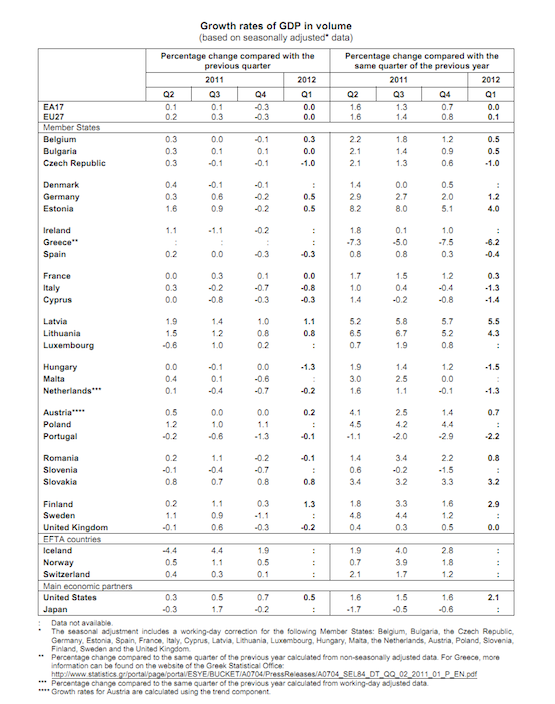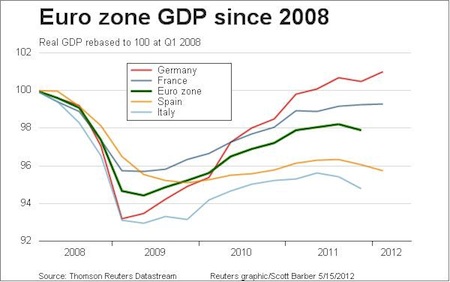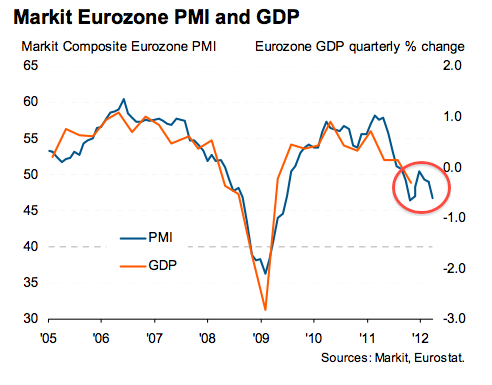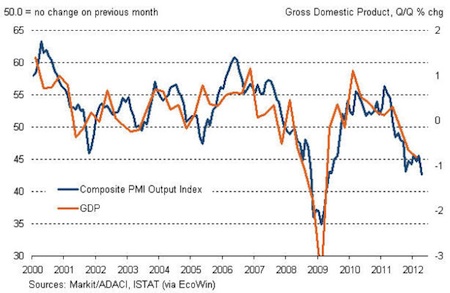European Q1 GDP data came out overnight. Germany was better than expected with a rise of 0.5% in the quarter and to 1.2% over the previous 12 months. France stagnated and the periphery continued to contract.
The German data was obviously a highlight, but as I spent much of last year explaining, good German data is a double edged sword. Although it is good for Germany, it is a big negative for the rest of Europe because one of the major issues that brought on the crisis in the first place was the competitiveness imbalance of nations under the single currency. As you can see from the chart below, countries that that are the major source of European risk continue to suffer economic contraction which, given the renewed strength of Germany, makes this imbalance worse:

This is something I would expect to see in the macro-economic environment that peripheral Europe finds itself. Austerity has a tendency to bring about rises in unemployment and falls in industrial production. Another look at Germany compared to “at risk” countries clearly shows that peripheral Europe has rolled back over in terms of growth while Germany accelerates away:

Also of note is that the PMI data showed that Europe got quite a “pop” in the lead up to Q1:

Since that time, however, the PMI data has been getting steadily worse, with the last data continuing to show deterioration, so it could just be that Q2 data will show a re-newed GDP deterioration across Europe. Italy was probably the worse performer in terms of downside surprises with GDP falling 0.8% in Q1 and again the PMI data suggest worse is yet to come:

As I have talked about previously, Italy needs economic growth but is pushing against both a demographic and historical tide. This latest data shows that the growth just isn’t coming, and with yesterday’s banking downgrade from Moody’s, Italy could very quickly become the next point of “flare up” for Europe. Italian and Spanish yields continued to climb overnight.
In the short term, however, the point of flare up is still Greece which once again tipped the markets into the red overnight as the President announced that the country was heading for new elections:
Attempts to form a government in Greece collapsed on Tuesday, jolting financial markets at the prospect that leftists opposed to the terms of an EU bailout could sweep to victory in a June election and tip the euro zone deeper into crisis.
…
In Athens, President Karolos Papoulias abandoned efforts to broker a compromise on a cabinet of technocrats to steer the country away from bankruptcy, nine days after an inconclusive general election. A caretaker government will now be formed pending a new vote probably in mid-June.
“We resisted in every way,” said Alexis Tsipras, leader of the hard-left SYRIZA party, which surged to second place in last week’s election on an anti-austerity platform and blocked any deal with pro-bailout mainstream parties.
“We made the decision to not betray your hopes and your expectations,” said Tsipras, emboldened by opinion polls showing his party could top the poll in a second vote. “Now it’s time to complete it: We will consign in the dustbin of history all the spent forces of the past.”
As H&H stated last week there is no point guessing what happens next. SYRIZA needs only a small swing from New Democracy and/or PASOK to be able to form government with another Leftist party. After that…well…who knows?
In the meantime a some hold-outs took advantage of the turmoil by getting paid out in full on their foreign-law Greek bonds. At least someone is still smiling about Europe.